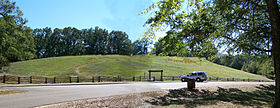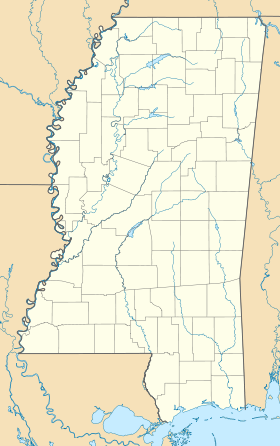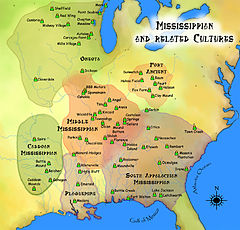- Mangum Mound Site
-
Mangum Mound Site
22 CB 584
Mangum MoundCoordinates: 31°59′30.2994″N 90°53′59.136″W / 31.991749833°N 90.89976°W Location Country:  USA
USARegion: Claiborne County, Mississippi Nearest town: Port Gibson History Culture: Plaquemine culture Period: Foster Phase Excavation and maintenance Responsible body: State of Mississippi Dates excavated: 1936, 1951, 1963 Notable archaeologists: Charles F. Bohannon Architecture Mangum Mound Site (22 CB 584) is an archaeological site of the Plaquemine culture in Claiborne County, Mississippi. It is located at milepost 45.7 on the Natchez Trace Parkway.[1] Two very rare Mississippian culture repoussé copper plates have been discovered during excavations of the site. The site was used as a burial mound during the Foster Phase (1350 to 1500 CE) and is believed to have been abandoned before the 1540 expedition of Hernando de Soto.[2]
Contents
Description
The site has one burial mound. It was first investigated in 1936 by its owner Spurgeon C. Mangum, a farmer. Mangum found human remains, various pottery fragments belonging to the Plaquemine culture, chunkey stones and three fragments of an repoussé copper plate with an avian design similar to other plates found throughout the American Midwest and Southeast. These portray the Birdman motif important to the Southeastern Ceremonial Complex (SECC).[3] The site underwent a series of test excavations in April 1951 as part of the Natchez Trace Park Survey.[3] During these excavations, twelve extended burials and possibly one bundled burial were found.[4]
The site was excavated in 1963 for the National Park Service by archaeologist Charles F. Bohannon. Bohannon and his team found the burials of numerous individuals. One individual, believed to have been a woman in her late 30s, possessed markings on her bones which suggested to investigators that she suffered from multiple myeloma.[5] Bohannon excavated the remains of eighty-four individuals, of which more than half were bundled burials. Some of the bundles seemed little more than disarticulated piles of bones, and Bohannon came to believe they were earlier burials that had been moved to make way for new extended burials. Another copper plate was also found during these excavations.[4]
See also
References
- ^ "Mangum Mound Natchez Trace". http://www.natcheztracetravel.com/natchez-trace-mississippi/vicksburg-port-gibson-ms/186-mangum-mound.html. Retrieved 2011-10-18.
- ^ R. C. Bildart (March 1996). Natchez Trace. Farcountry Press. p. 28. ISBN 978-1560370925. http://books.google.com/books?id=OFHWJR_OZScC&pg=PA29&lpg=PA29&dq=mangum+mound&source=bl&ots=8nhyaskMHK&sig=leMv_CgvU-HhgZBg8RVrEQUbbFA&hl=en&ei=NgmdTojEIISpsALBy6WTCg&sa=X&oi=book_result&ct=result&resnum=6&ved=0CEAQ6AEwBTgU#v=onepage&q=mangum%20mound&f=false.
- ^ a b "The Mangum Plate". American Antiquity 18 (1): 65. July 1952. http://www.jstor.org/pss/276247.
- ^ a b Galloway, Patricia (1995). Choctaw Genesis, 1500-1700 (Indians of the Southeast). University of Nebraska Press. p. 284. ISBN 0803270704. http://books.google.com/books?id=2HVOImebydMC&pg=PA284&lpg=PA284&dq=Mangum+copper+plate&source=bl&ots=pJYAMchE33&sig=Wdj9XTjL5tkOgKhDz0RCtl67rrA&hl=en&ei=QIedTs7BEOumsQKUy63RCQ&sa=X&oi=book_result&ct=result&resnum=4&ved=0CF0Q6AEwAw#v=onepage&q=Mangum%20copper%20plate&f=false.
- ^ Morse, Dan F.; Dailey, R. C.; Bunn, Jennings. "Prehistoric multiple myeloma". http://www.ncbi.nlm.nih.gov/pmc/articles/PMC1749372/pdf/bullnyacadmed00171-0009.pdf. Retrieved 2011-10-18.
External links
- Recommendations for mound maintenance and visitor use and access of the Natchez Trace Parkway Mounds
- UM Museum of Anthropology
 Pre-Columbian North America
Pre-Columbian North AmericaArchaeological cultures North American pre-Columbian chronology – Adena – Alachua – Ancient Pueblo (Anasazi) – Baytown – Belle Glade – Buttermilk Creek Complex – Caborn-Welborn – Calf Creek – Caloosahatchee – Clovis – Coles Creek – Deptford – Folsom – Fort Ancient – Fort Walton – Fremont – Glades – Glacial Kame – Hopewell (List of Hopewell sites) – Hohokam – Leon-Jefferson – Mississippian (List of Mississippian sites) – Mogollon – Monongahela – Old Cordilleran – Oneota – Paleo-Arctic – Paleo-Indians – Patayan – Plano – Plaquemine – Poverty Point – Prehistoric Southwest – Red Ocher – Santa Rosa-Swift Creek – St. Johns – Steed-Kisker – Tchefuncte – Tocobaga – Troyville
Archaeological sites Angel Mounds – Bandelier National Monument – The Bluff Point Stoneworks – Cahokia – Chaco Canyon – Casa Grande – Coso Rock Art District – Eaker – Effigy Mounds National Monument – Etowah Indian Mounds – Eva – Folsom Site – Fort Ancient – Fort Center – Gila Cliff Dwellings National Monument – Holly Bluff Site – Hopewell Culture National Historical Park – Kincaid Mounds – Kolomoki – Manitou Cliff Dwellings – Marksville – Meadowcroft Rockshelter – Mesa Verde – Moorehead Circle – Moundville – Mummy Cave – Nodena Site – Ocmulgee National Monument – Old Stone Fort – Parkin Park – Pinson Mounds – Portsmouth Earthworks – Poverty Point – Pueblo Bonito – Rock Eagle – Rock Hawk – Salmon Ruins – Serpent Mound – Spiro Mounds – SunWatch – Taos Pueblo – Toltec Mounds – Town Creek Indian Mound – WintervilleMiscellaneous Ballgame – Black drink – Buhl woman – Calumet – Chunkey – Clovis point – Container Revolution – Eastern Agricultural Complex – Eden point – Effigy mound – Falcon dancer – Folsom point – Green Corn Ceremony – Horned Serpent – Kennewick man – Kiva – Metallurgy – Mi'kmaq hieroglyphic writing – Medicine wheel – Mound builders – N.A.G.P.R.A. – Norse colonization of the Americas – Piasa – Pueblo dwellings – Southeastern Ceremonial Complex – Three Sisters agriculture – Thunderbird – Underwater panther
Categories:- Plaquemine Mississippian culture
- Archaeological sites in Mississippi
- Geography of Claiborne County, Mississippi
- Native American history of Mississippi
- Natchez Trace
Wikimedia Foundation. 2010.



